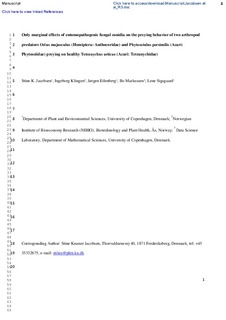Entomopathogenic fungal conidia marginally affect the behavior of the predators Orius majusculus (Hemiptera: Anthocoridae) and Phytoseiulus persimilis (Acari: Phytoseiidae) foraging for healthy Tetranychus urticae (Acari: Tetranychidae)
Journal article, Peer reviewed
Accepted version
Permanent lenke
http://hdl.handle.net/11250/2635955Utgivelsesdato
2019-11-20Metadata
Vis full innførselSamlinger
Originalversjon
Experimental & applied acarology. 2019, 79 (3-4), 299-307. 10.1007/s10493-019-00441-wSammendrag
We determined how conidia of arthropod-pathogenic fungi on leaves affected the behavior of two predators—Orius majusculus (Hemiptera: Anthocoridae) and Phytoseiulus persimilis (Acari: Phytoseiidae)—when offered a choice between preying on two-spotted spider mites, Tetranychus urticae (Acari: Tetranychidae), in the presence or absence of infective conidia of Metarhizium brunneum (Ascomycota: Hypocreales) and Neozygites floridana (Entomophthoromycota: Neozygitaceae). The results indicate no significant relation between the presence of conidia and predator behavior. The only indication of interference is between the generalists O. majusculus and M. brunneum, with a trend towards more time spent feeding and more prey encounters turning into feeding events on leaf discs without conidia than on leaf discs with conidia. Our results show that the presence of fungal conidia does not alter the preying behavior of the predators, and using predators and fungi together is not limited by any interference between organisms in the short term.
